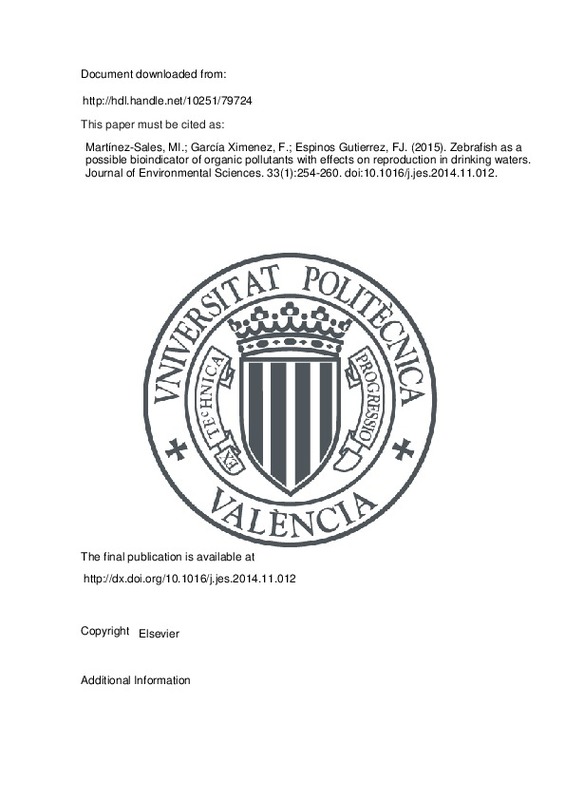JavaScript is disabled for your browser. Some features of this site may not work without it.
Buscar en RiuNet
Listar
Mi cuenta
Estadísticas
Ayuda RiuNet
Admin. UPV
Zebrafish as a possible bioindicator of organic pollutants with effects on reproduction in drinking waters
Mostrar el registro sencillo del ítem
Ficheros en el ítem
| dc.contributor.author | Martínez-Sales, María Isabel
|
es_ES |
| dc.contributor.author | García Ximenez, Fernando
|
es_ES |
| dc.contributor.author | Espinos Gutierrez, Francisco Juan
|
es_ES |
| dc.date.accessioned | 2017-04-18T09:51:44Z | |
| dc.date.available | 2017-04-18T09:51:44Z | |
| dc.date.issued | 2015-07-01 | |
| dc.identifier.issn | 1001-0742 | |
| dc.identifier.uri | http://hdl.handle.net/10251/79724 | |
| dc.description.abstract | [EN] Organic contaminants can be detected at low concentrations in drinking water, raising concerns for human health, particularly in reproduction. In this respect, we attempted to use the zebrafish as a bioindicator to detect the possible presence of these substances in drinking water, aiming to define the most relevant parameters to detect these substances, which particularly affect the development and reproduction of zebrafish. To this end, batches of 30 embryos with the chorion intact were cultured in drinking waters from different sources, throughout their full life-cycle up to 5 months, in 20 L tanks. Six replicates were performed in all water groups, with a total of 24 aquariums. Two generations (F0 and Fl) were studied and the following parameters were tested: in the F0 generation, survival and abnormality rates evaluated at 5 dpf (days post-fertilization) and at 5 mpf (months post-fertilization), the onset of spawning and the fertility rate from 3 mpf to 5 mpf, and the sex ratio and underdeveloped specimens at 5 mpf. Furthermore, in the F0 offspring (F1), survival and abnormality rates were evaluated at 5 dpf and the hatching rate at 72 hpf. These results revealed that the hatching rate is the most sensitive parameter to distinguish different levels of effects between waters during the early life stages, whereas the rate of underdeveloped specimens is more suitable at later life stages. Regarding adult reproduction, fertility rate was the most sensitive parameter. The possible reversibility or accumulative nature of such effects will be studied in future work. (C) 2015 The Research Center for Eco-Environmental Sciences, Chinese Academy of Sciences. Published by Elsevier B.V. | es_ES |
| dc.language | Inglés | es_ES |
| dc.publisher | Elsevier | es_ES |
| dc.relation.ispartof | Journal of Environmental Sciences | es_ES |
| dc.rights | Reserva de todos los derechos | es_ES |
| dc.subject | Organic pollutants | es_ES |
| dc.subject | Bioindicator | es_ES |
| dc.subject | Development and reproduction parameters | es_ES |
| dc.subject | Drinking water | es_ES |
| dc.subject | Zebrafish | es_ES |
| dc.subject.classification | BIOLOGIA ANIMAL | es_ES |
| dc.subject.classification | PRODUCCION ANIMAL | es_ES |
| dc.title | Zebrafish as a possible bioindicator of organic pollutants with effects on reproduction in drinking waters | es_ES |
| dc.type | Artículo | es_ES |
| dc.identifier.doi | 10.1016/j.jes.2014.11.012 | |
| dc.rights.accessRights | Abierto | es_ES |
| dc.contributor.affiliation | Universitat Politècnica de València. Grupo de Acuicultura y Medio Ambiente | es_ES |
| dc.contributor.affiliation | Universitat Politècnica de València. Escuela Técnica Superior de Ingeniería Agronómica y del Medio Natural - Escola Tècnica Superior d'Enginyeria Agronòmica i del Medi Natural | es_ES |
| dc.contributor.affiliation | Universitat Politècnica de València. Departamento de Ciencia Animal - Departament de Ciència Animal | es_ES |
| dc.description.bibliographicCitation | Martínez-Sales, MI.; García Ximenez, F.; Espinos Gutierrez, FJ. (2015). Zebrafish as a possible bioindicator of organic pollutants with effects on reproduction in drinking waters. Journal of Environmental Sciences. 33(1):254-260. doi:10.1016/j.jes.2014.11.012 | es_ES |
| dc.description.accrualMethod | S | es_ES |
| dc.relation.publisherversion | http://dx.doi.org/10.1016/j.jes.2014.11.012 | es_ES |
| dc.description.upvformatpinicio | 254 | es_ES |
| dc.description.upvformatpfin | 260 | es_ES |
| dc.type.version | info:eu-repo/semantics/publishedVersion | es_ES |
| dc.description.volume | 33 | es_ES |
| dc.description.issue | 1 | es_ES |
| dc.relation.senia | 302700 | es_ES |
| dc.identifier.eissn | 1878-7320 | |
| dc.identifier.pmid | 26141900 |







![[Cerrado]](/themes/UPV/images/candado.png)

